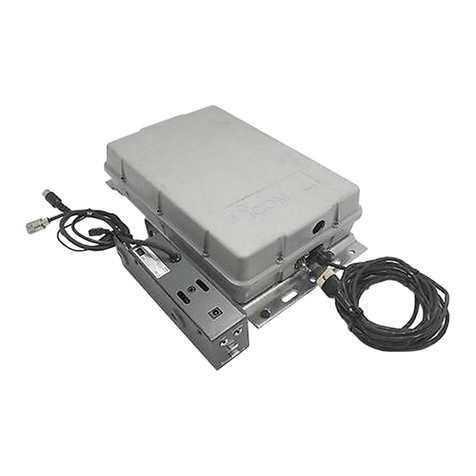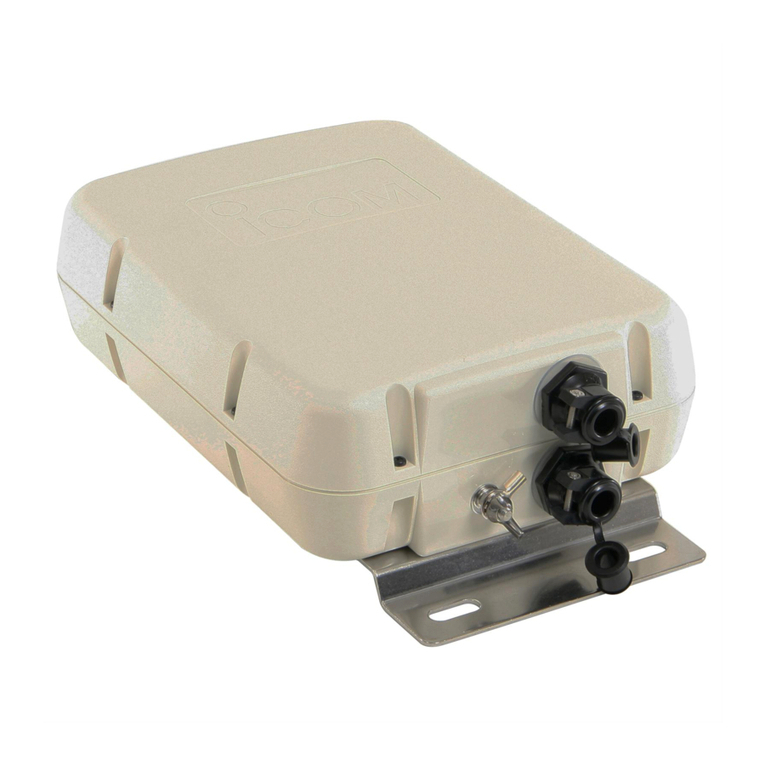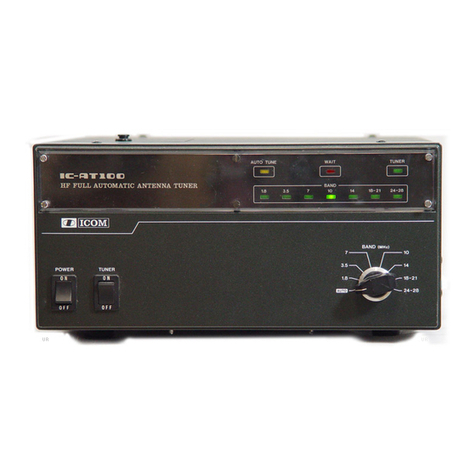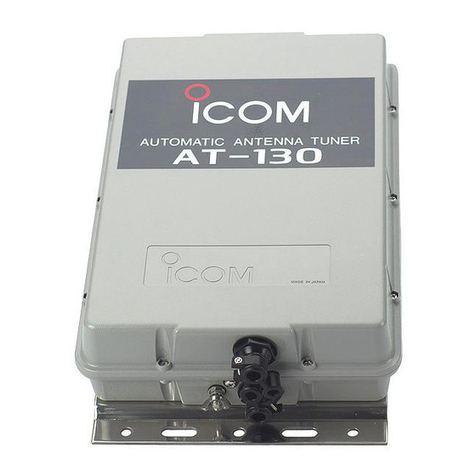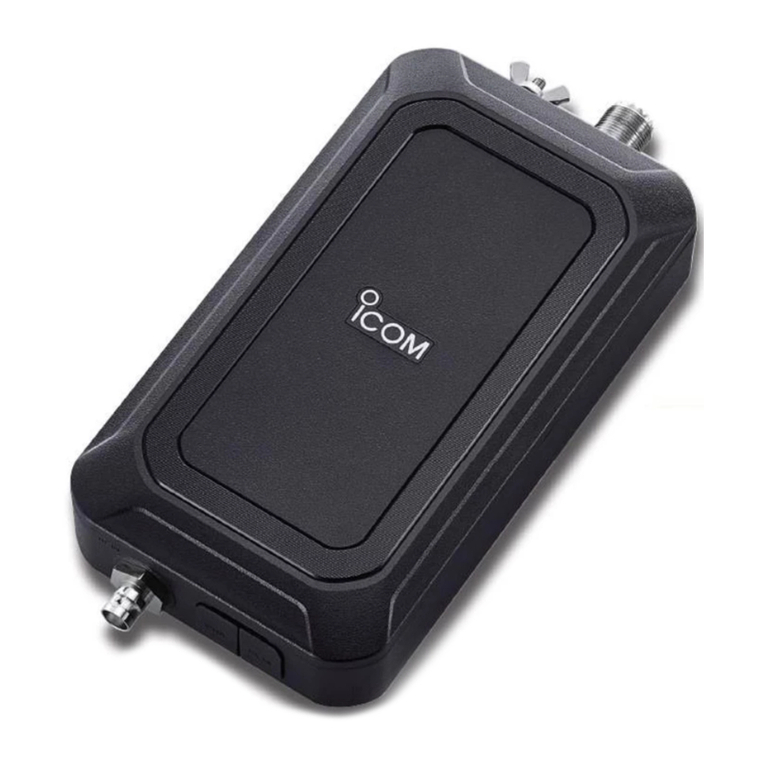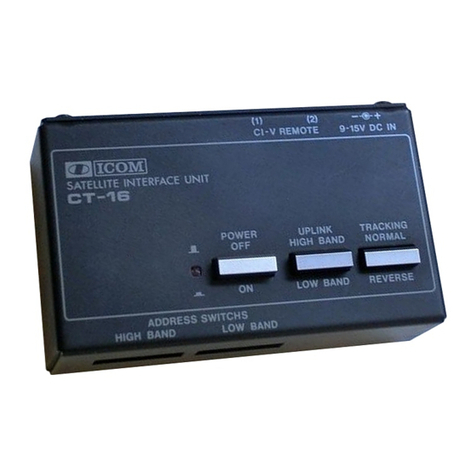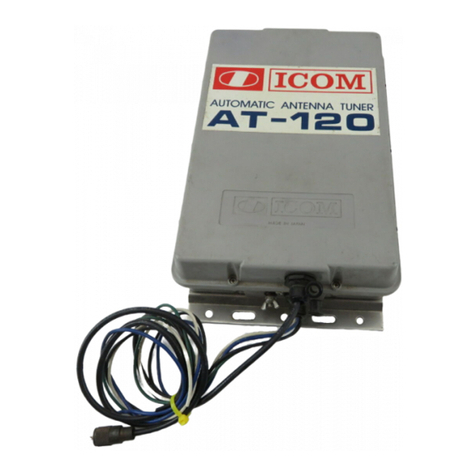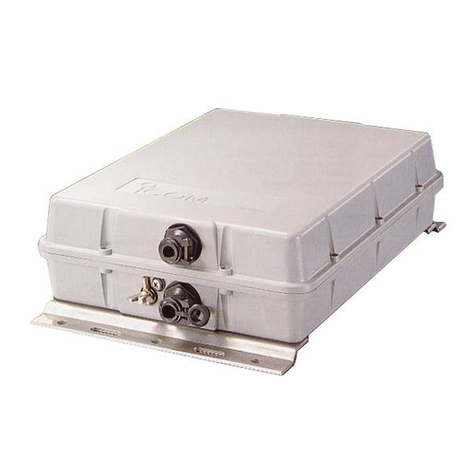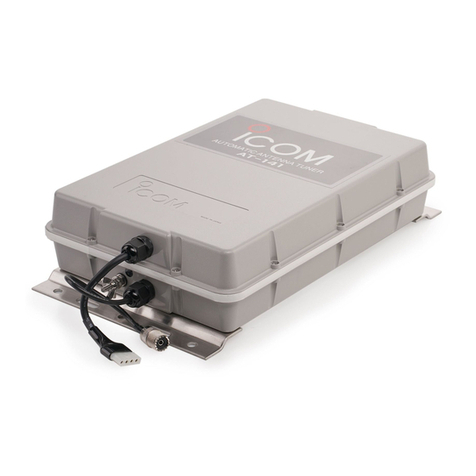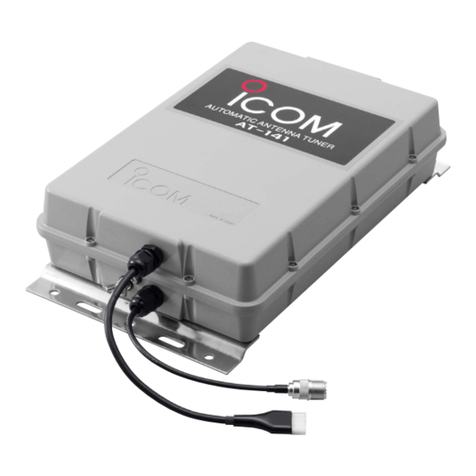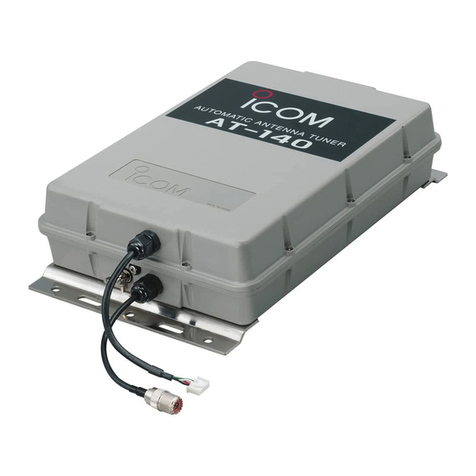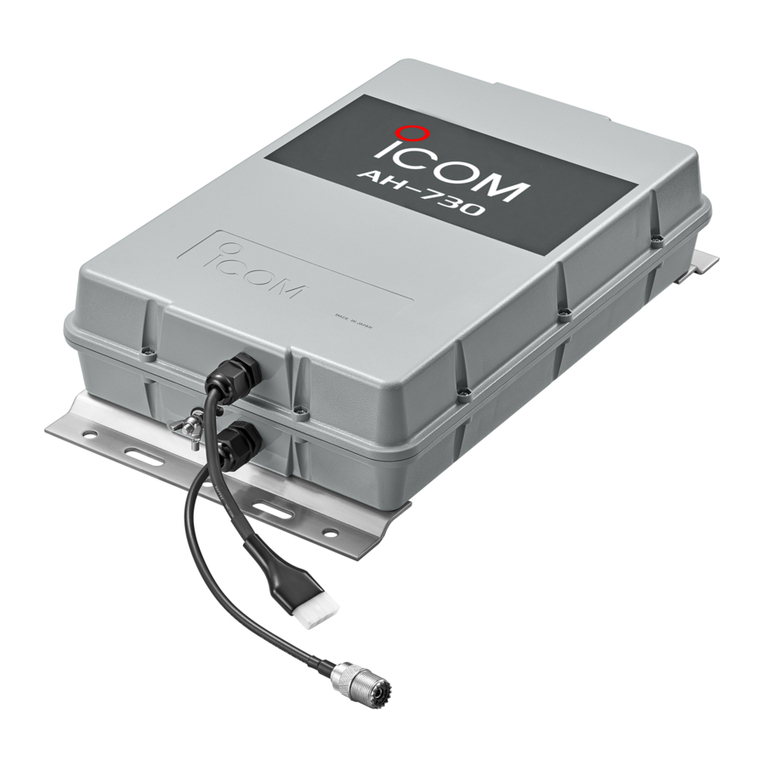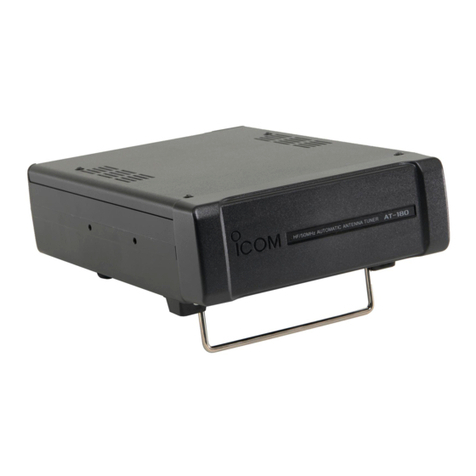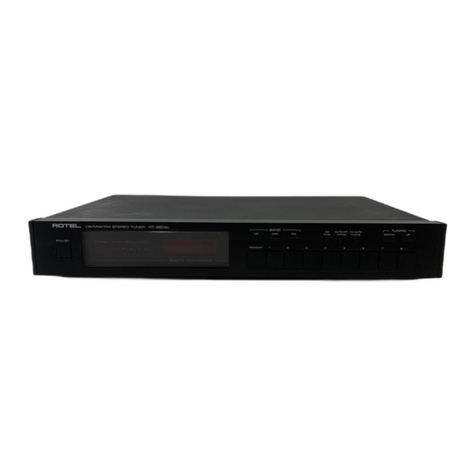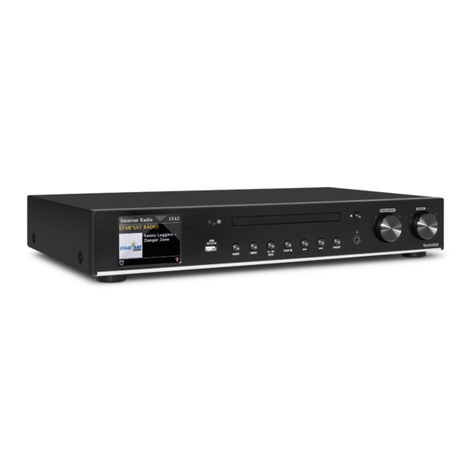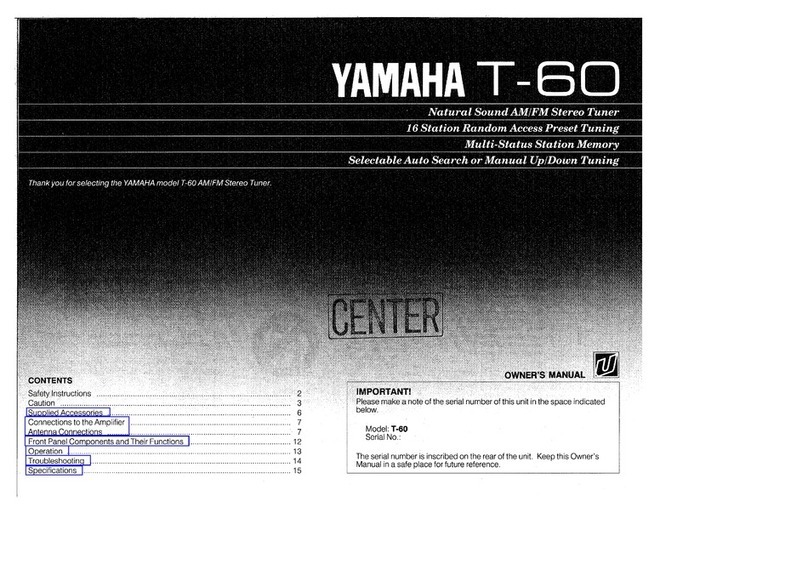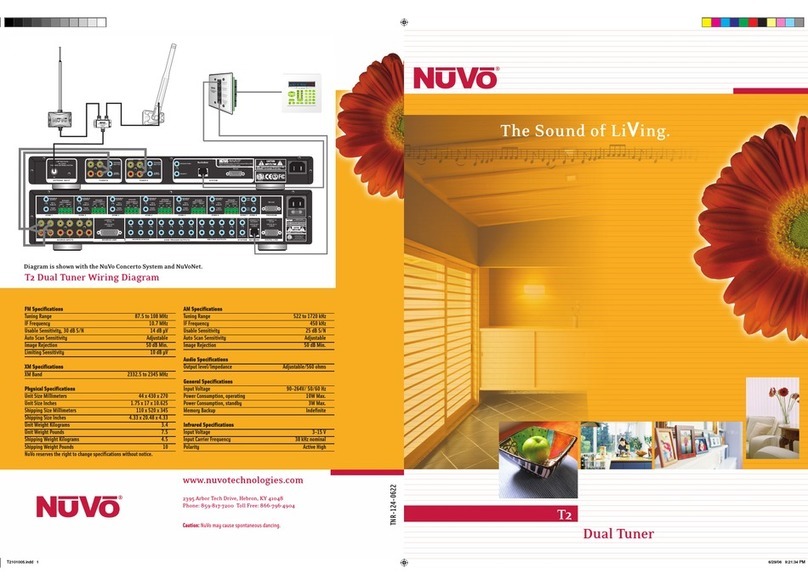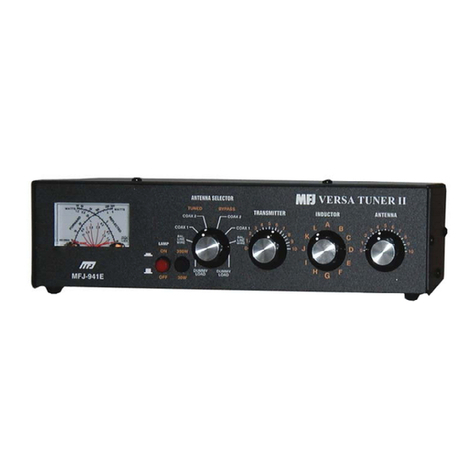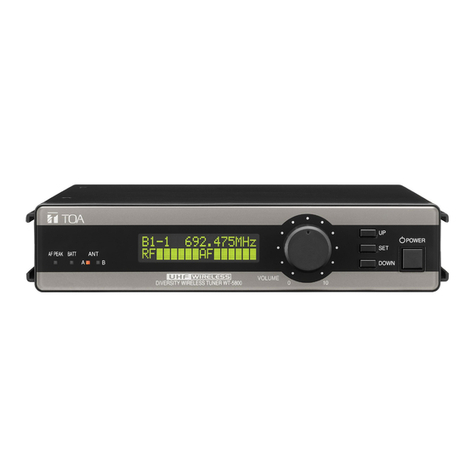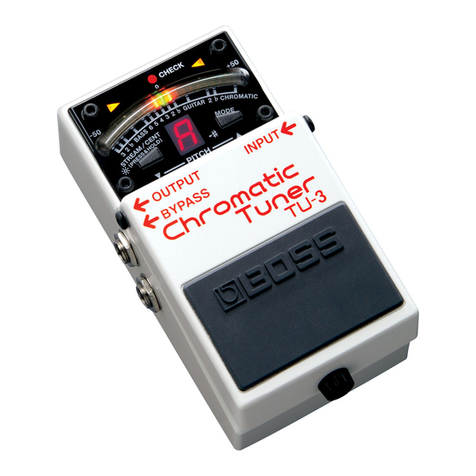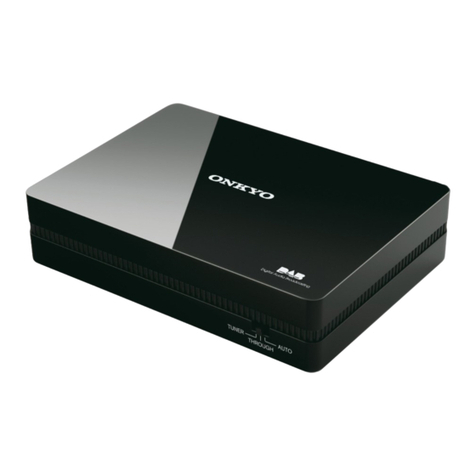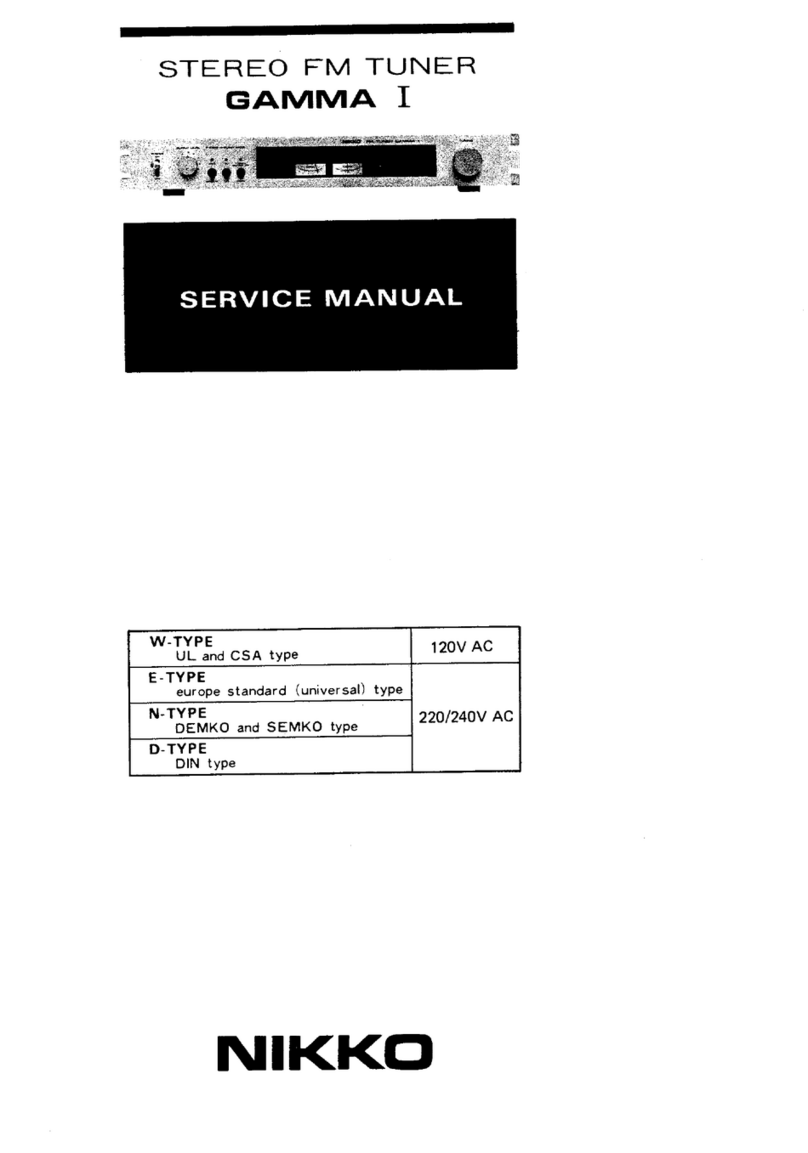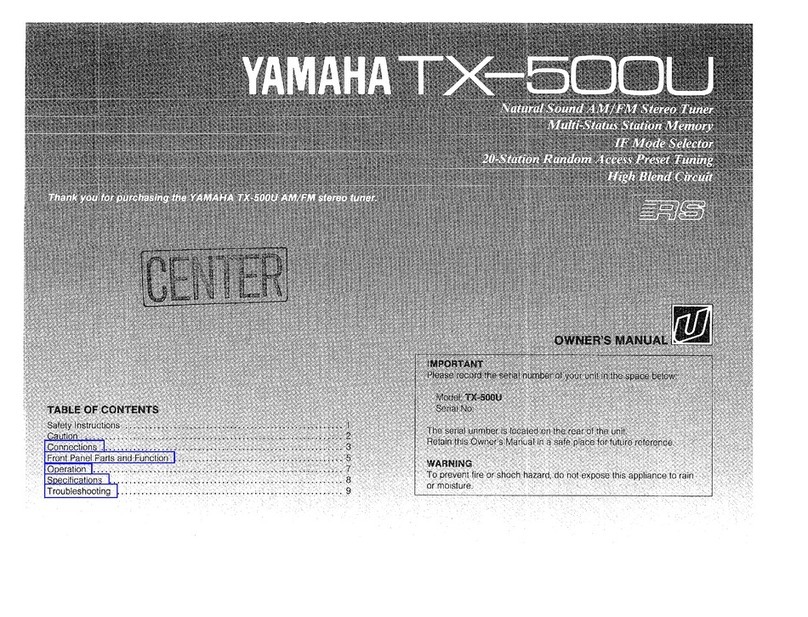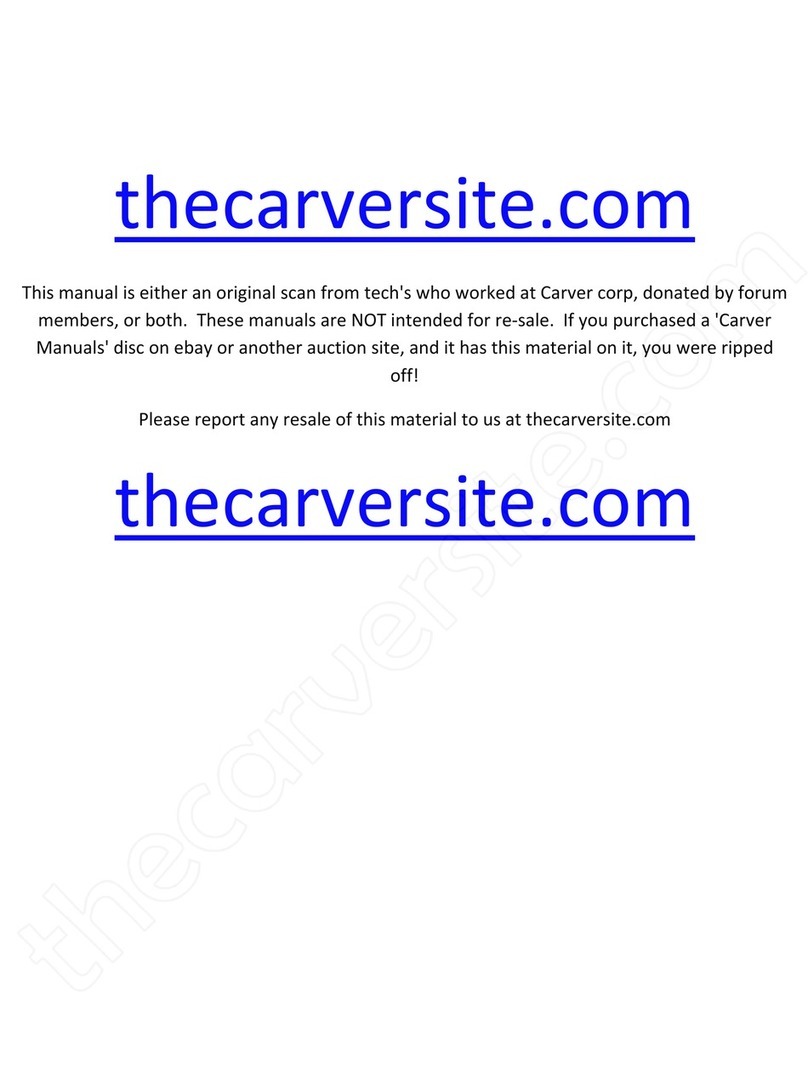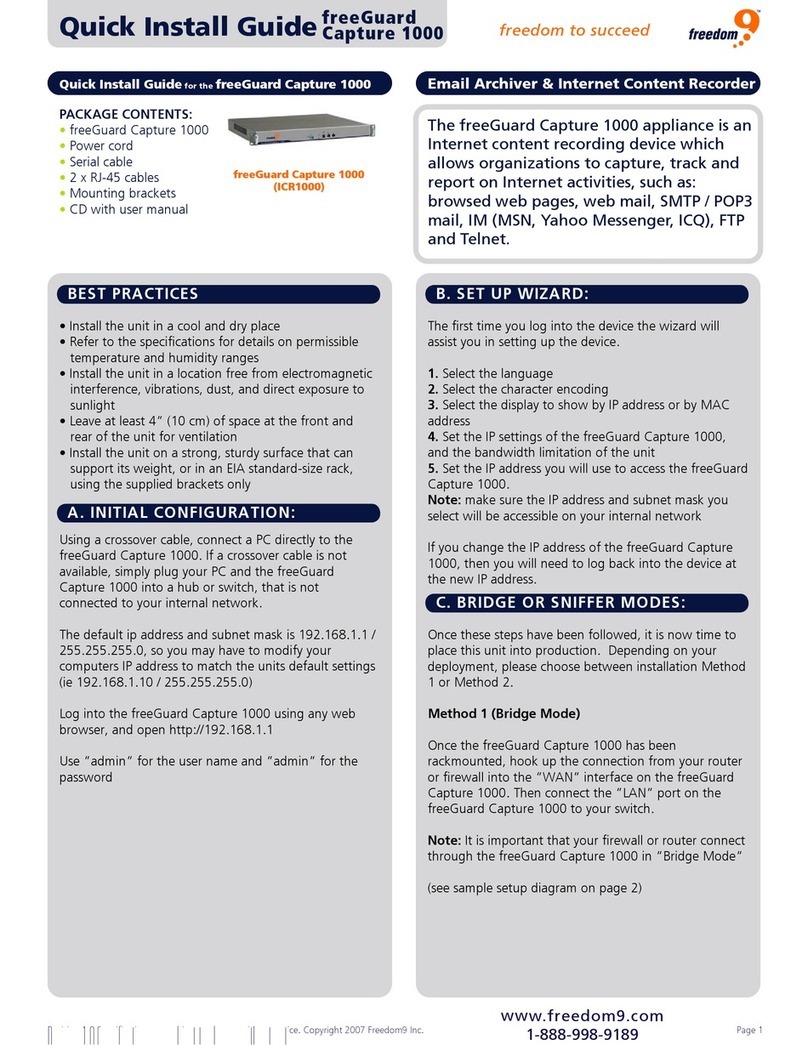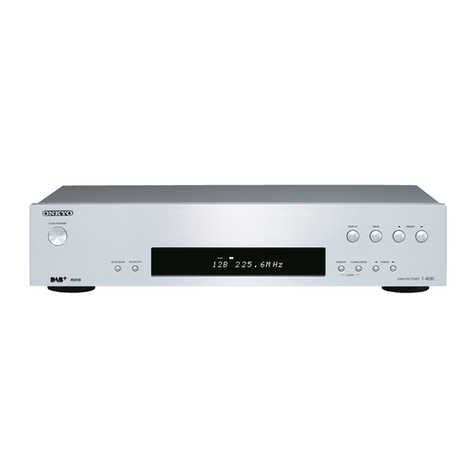Icom AT-140 User manual

HF AUTOMATIC
ANTENNA TUNER
AT-140
INSTRUCTION MANUAL

i
FOREWORD
Thank you for purchasing the AT-140 HF AUTO-
MATIC ANTENNA TUNER.
The AT-140 is designed, primarily for use with Icom HF
transceivers.
Refer to your HF transceiver instruction manual for
operation. If you have any questions, contact your
dealer.
IMPORTANT
READ ALL INSTRUCTIONS carefully and com-
pletely before using the AT-140.
SAVE THIS INSTRUCTION MANUAL. This
instruction manual contains important safety and
installation instructions.
EXPLICIT DEFINITIONS
WORD DEFINITION
RDANGER! Personal death, serious injury or an
explosion may occur.
RWARNING! Personal injury, fire hazard or elec-
tric shock may occur.
CAUTION Equipment damage may occur.
NOTE
If disregarded, inconvenience only.
No risk of personal injury, fire or elec-
tric shock.
PRECAUTIONS
RDANGER HIGH VOLTAGE! NEVER touch
the antenna terminal, ground terminal, antenna or
counterpoise while transmitting. Place the AT-140,
antenna and counterpoise in positions where no one
can touch them.
RWARNING! NEVER transmit during internal
adjustment. This may cause an electric shock.
NEVER use without a ground connection.
USE the ground terminal for ground connection.
The mounting plate is not connected internally.
DO NOT operate your HF marine transceiver without
running the boat’s engine.
DO NOT use the AT-140 in areas where the temper-
ature is below –30°C (–22°F) or above +60°C (+140°F).
The following accessories are supplied with the AT-140.
Qty.
qU-bolts ……………………………………………… 2
wU-bolt plates ……………………………………… 2
eFlat washers (M6 large) ………………………… 8
rFlat washers (M6 small) ………………………… 4
tSpring washers (M6) ……………………………… 8
yNuts (M6) …………………………………………… 8
uHex head bolts (M6×50) ………………………… 4
iSelf-tapping screws (A0 6×30) …………………… 4
oWeatherproof cap ………………………………… 1
!0 Rubber vulcanizing tape ………………………… 1
!1 4-pin/6-pin connector* …………………………… 1
!2 Connector pins* …………………………………… 4
!3 Ground cable (OPC-412) ………………………… 1
*The supplied pin connector and connector pins may differ,
depending on the version.
Icom, Icom Inc. and the Icom logo are registered trademarks of Icom Incorporated (Japan) in Japan, the United States, the Unit-
ed Kingdom, Germany, France, Spain, Russia and/or other countries.
q
w
e
r
t
y
u
i
o
!1
!2
!3
!0
Mounting plate
Ground terminal
SUPPLIED ACCESSORIES

ii
MISCELLANEOUS ITEMS
The following parts are additionally required for instal-
lation, but are not supplied with the AT-140.
Purchase these parts locally.
qAWG 14×4 conductor shielded cable
•
Icom offers an optional OPC-1147/N c o n t r o l c a b l e .
Length: 10 m (32.8 feet)
w50 Ωcoaxial cable
eTwo PL-259 connectors
FEATURES
Matches all bands
The AT-140 matches all frequencies on the HF marine
band. For example, the tuner matches a 7 m (23 feet)
long wire antenna across 1.6–30 MHz.
Full automatic tuning
Just push the [TUNE] key on the transceiver, and the
AT-140 immediately tunes for a minimum SWR on any
frequency in the HF marine band.
HF operation on any size ship
The AT-140 allows HF operation where antenna ele-
ment length is restricted due to space.
Weather resistant
The AT-140 is housed in a durable, completely weather
resistant ASA case, with a rubber gasket. The antenna
tuner can be conveniently installed both on the deck or
in the cabin near the antenna element.
Simple installation
Installation is simple. Just connect the control and
antenna cables. You never need to open the cover.
45 memories for shorter tuning time
To decrease the tune-up time, the AT-140 automatically
stores the matching conditions for up to 45 frequencies.
Re-tuning for a memorized frequency takes approxi-
mately 1 second.
Super capacitor for memory backup
Even if the AT-140 is not used for approximately 1
week, the built-in super capacitor backs up the con-
tents of the 45 memories.
Low power tune up
The AT-140 emits low output power during tuning. This
feature reduces the possibility of causing interference
to other stations.
Tuner Through function
The Tuner Through function is built into the AT-140.
This function helps improve receiver gain, depending
on the antenna element length used, and the operat-
ing frequency.
TABLE OF CONTENTS
FOREWORD����������������� i
IMPORTANT ����������������� i
EXPLICIT DEFINITIONS ����������� i
PRECAUTIONS ��������������� i
SUPPLIED ACCESSORIES ���������� i
MISCELLANEOUS ITEMS����������� ii
FEATURES ����������������� ii
TABLE OF CONTENTS ������������ ii
1 ANTENNA SYSTEM ����������� 1–2
n Antenna for ship ………………………………… 1
n Antenna for land operation ……………………… 1
n Coaxial cable……………………………………… 2
n Ground and counterpoise ……………………… 2
2 INSTALLATIONS ������������� 3–5
n lnstallation outline………………………………… 3
n Control cable……………………………………… 3
n PL-259 connector………………………………… 4
n Waterproofing the antenna connection………… 4
n Mounting ………………………………………… 5
n Cable connections ……………………………… 5
3 CONTROL CABLE SIGNALS ������� 6–7
n Terminal information …………………………… 6
n Transceiver setting ……………………………… 7
4 UNIT DESCRIPTION AND SPECIFICATIONS �8
n Unit description…………………………………… 8
n Specifications …………………………………… 8

nAntenna for land operation
1
1
ANTENNA SYSTEM
nAntenna for ship
Required antenna element length
Required antenna element length to achieve full per-
formance varies, according to the lowest frequency.
The lowest frequency Required antenna element length
1.6 MHz band 7 m (23.0 feet) or longer
4 MHz band 3 m (9.8 feet) or longer
The longer the antenna element, the better the anten-
na efficiency.
Undesirable antenna element lengths
DO NOT use an antenna element such as multi-
ples of 1⁄2λ lengths (half wavelength), since tuning
becomes difficult.
L : Undesirable antenna element length [m]
f : Operating frequency [MHz]
n : Natural number (n = 1, 2, 3, ...)
L
=
300
f
1
2n
××
[Example]
At an operating frequency of 16 MHz, avoid the fol-
lowing antenna element lengths:
L=300
16
1
2n9.4, 18.8, ...
1 m 39 inches
××
For example, if 15 m (49.2) feet is selected for an
antenna element length, you have no problem in the
1.6–25 MHz marine bands range.
Insulator
Backstay operates as
a long wire antenna.
Insulator
Whip antenna
NOTE: Keep antennas as far away from other
objects as possible, especially metal objects.
In some countries, HF transceivers can be used
for land mobile operation. Ask your Icom Dealer for
details, since the radio law varies according to each
country.
For land mobile operation on 4 MHz or above, an
optional AH-2b antenna element is available. The
AH-2b includes a sturdy tow hook mount system for
holding a 2.5 m (8.2 feet) stainless steel antenna ele-
ment plus all the necessary hardware.
AH-2b
Refer to the AH-2b instruction manual for the AH-2b
and AT-140 installation to your vehicle. Ask your Icom
Dealer for details.
Connect a suitable antenna element for a base sta-
tion. To achieve full performance, refer to “Required
antenna element length” as described above.

2
1
ANTENNA SYSTEM
nCoaxial cable
Insulate the lead-in cable of the AT-140 antenna termi-
nal and antenna element from other metal objects.
To prevent interference, keep cables as far as possi-
ble from an antenna, electric pump and other elec-
tronic equipment.
To prevent erroneous indications, keep cables as far
away as possible from the flux gate compass.
Use suitable noise filters for alternators or fluorescent
lights. Ask your dealer for details.
nGround and counterpoise
Why a ship’s ground is required
The AT-140’s ground terminal MUST be connect-
ed to your ship’s ground. Grounding prevents elec-
tric shocks, interference to other equipment and other
problems. Grounding also ensures effective signal
transmission.
RDANGER! NEVER connect the ground ter-
minal to the following points. These connections may
cause an explosion or electric shocks:
• Gas or electrical pipe
• Fuel tank or oil-catch pan
IMPORTANT: The mounting plate is NOT connect-
ed to the AT-140’s internal ground.
Ideal ground points
One of following points is ideal:
• External ground plate
• External copper screen
• External copper foil
Good ground points
If electrically connected to sea water, one of the fol-
lowing points is usable:
• Stainless steel stanchion
• Through mast
• Through hull
• Metal water tank
Undesirable ground points
These connections may cause noise or electrolysis:
• Engine block
• Ship’s DC battery ground
Electrolysis
All ground cables from the AT-140 or HF transceiver
on your ship should be connected to only one ship’s
ground.
DO NOT connect to two or more points. Voltage dif-
ference between two or more ship’s grounds may
cause electrolysis.
DO NOT connect between dissimilar metals where
an electric current is present. These connections may
cause electrolysis.
Counterpoise
If your ship is made of FRP, etc. and a good ship’s
ground is not available, connect a counterpoise.
Ground terminal
AT-140
1
⁄
4
λradial for
each band
1⁄4λ(quarter wavelength) radial for each band is suita-
ble for a counterpoise. Install the counterpoise direct-
ly below the AT-140’s ground terminal. Insulate the
ends of each radial from other metal objects. Layout
the radial horizontally and as straight as possible.
L :
Counterpoise length for the operating frequency [m]
f : Operating frequency [MHz]
L=
300
f
1
4
×
[Example]
At an operating frequency of 16 MHz, use a counter-
poise with the following length:
L=300
16
1
44.7 [m]
1 m 39 inches
×
Ground cable
For best results, use the heaviest gauge wire or metal
strap. Make the distance between the AT-140’s ground
terminal and ship’s ground as short as possible.
The supplied ground cable can be used for ground
connection through a mast. Confirm that the mast is
electrically connected to sea water.
RWARNING!— When grounding to metal hull
Use a Zinc anode to protect the hull from electroly-
sis.
Ask your technical dealer or installer, or refer to
a technical book for RF ground details.

2
3
INSTALLATIONS
nInstallation outline
qConnect the control cable and four conductor
shielded cable.
• Refer to “Control cable” as described below.
wConnect and solder the PL-259 connector to the
coaxial cable.
Refer to page 4, “PL-259 connector.”
eMount the AT-140 in the desired location.
• Refer to page 5, “Mounting.”
rConnect the control and coaxial cables between
the transceiver and the AT-140.
• Refer to page 5, “Cable connections.”
tConnect the antenna to the ship’s ground or coun-
terpoise.
• Refer to page 1 “Antenna for ship,” and page 2
“Ground and counterpoise.”
nControl cable
Between the AT-140 and HF marine transceiver, con-
nect four control signal lines as shown below.
To prevent RF feedback, use a four conductor shield-
ed cable.
Connect the shield line to the [GND] terminal on the
transceiver.
Icom offers 10 m (32.8 feet) long control cables.
OPC-566 : for IC-M710/RT, M700PRO
OPC-1147/N : for IC-M802
Refer to page 6, “Terminal information” for details.
[GND]
Use the optional OPC-1147/N, or
assemble a four conductor shielded
cable of the desired length and the
connector kits supplied with the
transceiver and the tuner.
[E] : Black
[13.6] : Red
[STAR] : White
[KEY] : Green
[KEY] : Green
[STAR] : White
[13.6] : Red
[E] : Black
Use the optional OPC-566/1147/N
(either connector of the AT-140 or
the transceiver requires assembly),
or assemble a four conductor
shielded cable of the desired length
and the connector kits supplied with
the transceiver and the tuner.
DWhen connecting to Icom IC-M802
DWhen connecting to Icom IC-M710/RT, IC-M700PRO
DWhen connecting to Icom IC-M700/TY, IC-78
[E] : Black
[13.6] : Red
[STAR] : White
[KEY] : Green
[GND]
[GND]
[GND]
To the AT-140
OPC-1147 OPC-1147N
[E] : Black
[13.6] : Red
[STAR] : White
[KEY] : Green
[GND]
To the AT-140
[E] : Black
[13.6] : Red
[STAR] : White
[KEY] : Green
[GND]
To the AT-140
[E] : Black
[13.6] : Red
[STAR] : White
[KEY] : Green
To the transceiver
To the transceiver
To the transceiver
Use the optional OPC-1147/N (this
connector only requires assembly),
or assemble a four conductor
shielded cable of the desired length
and the connector kits supplied with
the transceiver and the tuner.
OPC-1147 OPC-1147N
OPC-1147 OPC-1147N

4
2
INSTALLATIONS
nPL-259 connector
qSlide the coupling ring down.
Strip the cable jacket and tin the shield.
w
Strip the cable as shown below.
Tin the center conductor.
1–2 mm
10 mm tin
eSlide the connector body on and solder it.
Solder Solder
rScrew the coupling ring onto the connector body.
nWaterproofing the antenna connection
CAUTION:
If you skip the following steps, moisture
will get into the connector, and this could damage
the antenna tuner.
q Cut off just the top of the weatherproof cap, and
pass the antenna wire through the cap.
w Insert the antenna wire into the opening of the
crimp-on wire terminal.
• Crimp or solder the antenna wire.
e
Put the star washer, crimp-on wire terminal, and
wing nut on the base nut, in that order, then, tighten
the wing nut.
• Make sure the base nut is tightened rmly, before
you tighten the wing nut. (See the Fig.1 to the
right.)
•
Carefully bend the wire terminal up, after you
tighten the wing nut.
(See the Fig.2 to the right.)
r Place the weatherproof cap over as much of the
insulator as possible.
• How far down it will go depends on the height of
the wing nut.
t
Start wrapping the rubber vulcanizing tape at the bot-
tom of the insulator, then the weatherproof cap and
finally the antenna wire to prevent water seeping.
• Wrap electrical tape* over the rubber vulcanizing
tape to secure waterproofing.
*The electrical tape is not supplied with the AT-140.
Insulator
et
r
Rubber
vulcanizing tape
Bend this part
up, AFTER
you tighten
the wing nut.
Antenna wire
Weatherproof cap
Crimp Solder
Wing nut
Star washer
Crimp-on wire terminal
Base nut
Antenna tuner
Fig.1
Fig.2
Coupling 30 mm
10 mm (tin here)
• 10 mm
3
⁄
8
inches
• 30 mm 1
3
⁄
16
inches
• 1–2 mm
1
⁄
32
–
3
⁄
32
inches
30 mm (13⁄16 inches) 10 mm (13⁄32 inches) 1–2 mm (1⁄32–3⁄32 inches)

5
2INSTALLATIONS
nMounting
CAUTION: Mount the AT-140 in a horizontal posi-
tion or in a vertical position with the antenna termi-
nal up.
Mounting on a Mast/Metal pole
Mounting on a flat surface
RWARNING! Mount the AT-140 securely with the
supplied nuts and bolts. Otherwise, vibrations and
shocks due to waves could loosen the antenna
tuner making if fall, causing personal injury.
Using U-bolts
U-bolt
U-bolt plate
Flat washer(L)
Spring washer
Nut
Mast/
Metal pole
Flat washer(S)
Using U-bolts
U-bolt
U-bolt plate
Flat washer (L)
Spring washer
Nut
Mast/
Metal pole
Flat washer (S)
qConnect the coaxial cable and the control cable
to the AT-140.
wWrap both the antenna and the control cable con-
nectors with rubber vulcanizing tape, and then
wrap electrical tape* over the rubber vulcanizing
tape to secure waterproofing.
*The electrical tape is not supplied with the AT-140.
eFix both of the coaxial and control cables to pro-
tect the inside connections.
DO NOT pull the antenna and control cable
receptacles. This may cause disconnection
(inside the AT-140), internal connector dam-
age or a bad connection.
rConnect the coaxial cable and the control cable
to the transceiver.
• See the transceiver instruction manual for details.
tGround the transceiver, AT-140 and shield cable
of the control cable via the ground terminal.
• See page 2 for grounding details.
IMPORTANT:— AT-140
NEVER ground the AT140 via the mounting
plate. It is not connected to ground internally.
Rubber vulcanizing tape
Control cable
Coaxial cable
Mounting plate
Ground terminal
Nut
Spring
washer
Flat
washer(L)
Flat
washer(L)
Hex head
bolt
Drill a hole here
Diameter:7–8 mm;
9
⁄
32
–
5
⁄
16
inches
Weatherproof cap
Flat
washer(S)
Nut
Spring
washer
Flat
washer (L)
Flat
washer (L)
Hex head
bolt
Drill a hole here
Diameter:7–8 mm;
9
⁄
32
–
5
⁄
16
inches
Flat
washer (S)
Nut
Spring
washer
Flat
washer (L)
Flat
washer (L)
Hex head
bolt
Drill a hole here
Diameter:7–8 mm;
9
⁄
32
–
5
⁄
16
inches
Flat
washer (S)
Using self-tapping
screws
Using nuts and bolts
Using self-tapping
screws
Using nuts and bolts
nCable connections
Ground
AT-140
Control cableCoaxial cable

6
3
CONTROL CABLE SIGNALS
6
nTerminal information
Consider the following points when using a non-Icom
transceiver.
Terminal Description
[KEY] Key voltage. Grounded during tuning.
Maximum current drain; 100 mA
[13.6] 13.6 V DC +input terminal.
Maximum current drain; 2 A
[STAR] Receives start voltage.
Maximum current drain; 1 mA
[ANTC] Antenna current detector output.
Start voltage [STAR]
When a start voltage (less than 1 V) is received, the
AT-140 begins automatic tuning.
8
6
4
2
0
Time
More than
350 milliseconds*
Approximately 7.5 V
Less than 1 V to
start tuning
Start
voltage
[V]
*For the Tuner Through function; Less than 250 milliseconds
Key voltage [KEY]
During automatic tuning, the AT-140 grounds the key
voltage line, and the HF transceiver reduces output
power.
8
6
4
2
0
Time
Key
voltage
[V]
Grounded
Approximately 7.5 V
During automatic tuning
If the key voltage is more than 8 V, switch the [MODE]
switch (S1) to OFF mode (lower position).
[KEY]
[STAR]
[13.6]
[E]
*The connector’s shape may differ,
depending on the version.
Mode switch (S1)
[E]
[13.6]
[STAR]
[KEY]
NORMAL mode
OFF mode
S1

7
CONTROL CABLE SIGNALS
3
7
nTransceiver setting
IC-M700 with serial number 2500 and below
In the IC-M700, change the [TUNE] switch set-
ting from the “1” position to the “2” position. Confirm
that the [KEY] switch is in the “2” position. See the
IC-M700 instruction manual’s page 9 for details.
[KEY] [TUNE]
Select “2” position.
Confirm “2” position.
Other IC-M700 and IC-M700TY
Nothing necessary to set. However, the Tuner Through
function is not available when using the AT-140 with
IC-M700/TY.
IC-78
In the IC-78, select the antenna tuner type as “AH-4*”
in initial set mode. See the IC-78 instruction manual’s
page 32 for details.
IC-M710/RT, IC-M700PRO
In the IC-M710/RT and IC-M700PRO, select the
antenna tuner type as “AH-3*” in initial set mode. See
the IC-M710/RT instruction manual’s page 13 or IC-
M700PRO instruction manual’s page 11 for details.
IC-M802
In the IC-M802, select the antenna tuner type as “AT-
140” in initial set mode. See the IC-M802 instruction
manual’s page 49 for details.
Non-Icom HF transceiver
Select correct settings for the start voltage and key
voltage. See your HF transceiver instruction manu-
al for details.
NOTE: When a non-Icom automatic tuner was
previously used, confirm the tuner settings. Refer
to the instruction manual for details.
*With “AT-130” setting, use of the AT-140 is possible,
however, the Tuner Through function cannot be oper-
ated.

8
4
UNIT DESCRIPTION AND SPECIFICATIONS
Antenna terminal
Mounting plate
Control cable receptacleAntenna cable receptacle
Mounting plate
Ground terminal
230 mm; 9.1 inches
80 mm; 3.1 inches
91.5 mm; 3.6 inches
340 mm; 13.4 inches
nSpecifications
nUnit description
• Frequency coverage : 1.6–30 MHz (with 7 m; 23.0 feet) or longer antenna element)
• Power supply requirement : 13.6 V DC (supplied from the HF transceiver)
• Current drain : Maximum 2 A
• Operating temperature range : –30°C to +60°C (–22°F to +140°F)
• Weight (approximately) : 2.5 kg; 5.5 lb
• Antenna connector : SO-239 (50 Ω)
• Maximum Input power : 150 W (PEP) 100 W (continuous)
• Automatic tuning time :
Approximately 2 to 3 seconds (general condition) Maximum 15 seconds
Approximately
1 second (re-tuning for a memorized frequency)
• Automatic tuning accuracy : SWR 2.0:1 (after tuning, except for multiples of 1⁄2 λ)
All stated specifications are subject to change without notice or obligation.

1-1-32 Kamiminami, Hirano-ku, Osaka 547-0003, Japan
A-6175H-1EX-r
Printed in Japan
© 2002–2010 Icom Inc.
Printed on recycled paper with soy ink.
Icom America Inc.
<Corporate Headquarters>
2380 116th Avenue NE, Bellevue, WA 98004, U.S.A.
Phone: +1 (425) 454-8155 Fax: +1 (425) 454-1509
URL: http://www.icomamerica.com
E-mail: [email protected]
<Customer service>
Phone: (425) 454-7619
Icom (Europe) GmbH
Communication Equipment
Auf der Krautweide 24,
65812 Bad Soden am Taunus, Germany
Phone: +49 (06196) 76685-0 Fax: +49 (06196) 76685-50
URL: http://www.icomeurope.com
E-mail: [email protected]
Icom Canada
Glenwood Centre #1150-6165 Highway 17, Delta,
B.C., V4K 5B8, Canada
Phone: +1 (604) 952-4266 Fax: +1 (604) 952-0090
URL: http://www.icomcanada.com
E-mail: [email protected]
Icom Spain S.L.
Ctra. Rubi, No. 88 “Edificio Can Castanyer”
08190, Sant Cugat del Valles, Barcelona, Spain
Phone: +34 (93) 590 26 70 Fax: +34 (93) 589 04 46
URL: http://www.icomspain.com
E-mail: [email protected]
Icom (Australia) Pty. Ltd.
Unit 1/103 Garden Road, Clayton Victoria, 3168,
Australia
Phone: +61 (03) 9549 7500
Fax: +61 (03) 9549-7505
URL: http://www.icom.net.au
E-mail: [email protected]
Icom (UK) Ltd.
BLACKSOLE HOUSE, ALTIRA PARK, HERNE BAY,
KENT, CT6 6GZ, U.K.
Phone: +44 (01227) 741741
Fax: +44 (01227) 741742
URL: http://www.icomuk.co.uk
E-mail: [email protected].uk
Icom New Zealand
146A Harris Road, East Tamaki, Auckland,
New Zealand
Phone: +64 (09) 274-4062 Fax: +64 (09) 274-4708
URL: http://www.icom.co.nz
E-mail: [email protected]
Icom France s.a.s.
Zac de la Plaine,
1 Rue Brindejonc des Moulinais, BP 45804,
31505 Toulouse Cedex 5, France
Phone: +33 (5) 61 36 03 03
Fax: +33 (5) 61 36 03 00
URL: http://www.icom-france.com
E-mail: [email protected]
Asia Icom Inc.
6F No. 68, Sec. 1 Cheng-Teh Road, Taipei, Taiwan,
R.O.C.
Phone: +886 (02) 2559 1899
Fax: +886 (02) 2559 1874
URL: http://www.asia-icom.com
E-mail: [email protected]
Icom Polska
Sopot, 3 maja 54, Poland
Phone: +48 (58) 550 7135 Fax: +48 (58) 551 0484
URL: http://www.icompolska.com.pl
E-mail: [email protected]
Other manuals for AT-140
2
Table of contents
Other Icom Tuner manuals
